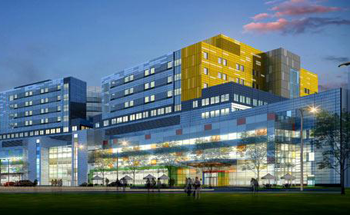Form Follows Function
 “Form follows function” is an old adage in architecture. The theory is that in any given project, the design should ultimately fit the purpose—a vital concept in the design of an Emergency Department (ED), where patient flow bottle-necks can cause problems across an entire hospital.
“Form follows function” is an old adage in architecture. The theory is that in any given project, the design should ultimately fit the purpose—a vital concept in the design of an Emergency Department (ED), where patient flow bottle-necks can cause problems across an entire hospital.
For the new ED at the Glen Campus, MUHC clinicians and planners visited hospitals far and wide, and came to the conclusion that a much more efficient design should be used than the current “pod” configuration common in the past.
“We’re using this opportunity to create new processes that will make us more effective and streamline operations,” says Dr. Jean-Marc Troquet, Chief of the Department of Emergency Medicine. Enter: the linear design ED.
As the name suggests, the linear design, also known as an accordion design, is essentially a single channel that can be expanded or contracted according to needs, such as changes in the number of patients and staff over time.
The central core of the ED is an open area adjacent to the treatment rooms, where personnel can visually monitor patients as well as interact and assist other staff members. Sliding glass doors allow for clear lines of sight into treatment rooms.
“The new design will improve patient flow, as well as maximize privacy and help provide a sense of calm to patients and their family members,” says Dr. Harley Eisman, Director of the Montreal Children’s Hospital ED. The linear design should also provide a more efficient working environment and improve wayfinding.
“We’re planning for a lot of different scenarios ahead of time,” continues Dr. Eisman. “For example, the design takes pandemic and major trauma situations into consideration—it’s not an afterthought.” Should a pandemic occur, both EDs can be separated into “clean” and “contaminated” zones. This zoning includes separate ventilation systems to ensure appropriate segregation during a respiratory outbreak and designated staff and patient entrances for infection control.
The new linear ED design at the Glen, which will be the first of its kind in Quebec, and one of only a few in Canada, is sure to promote improved emergency care.